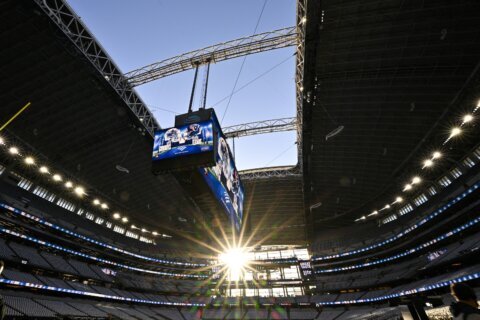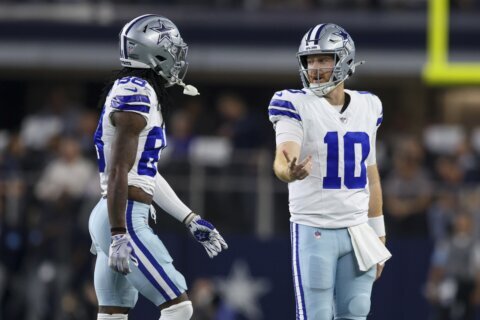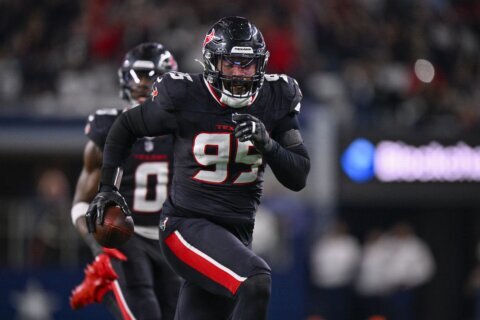IRVINE, Calif. (AP) — New Orleans Saints special teams coach Darren Rizzi said he felt like a real estate agent during the early days of training camp, urging kickers to scrap their long-held, deep-ball approach to kickoffs and focus instead on “location, location, location.”
“You’ve got to get the old mentality out of your heads,” Rizzi said. “The No. 1 aspect is going to be where that kickoff lands.”
Rams special teams coordinator Chase Blackburn put it this way: “In a kickoff perspective, all of the kickers are rookies.”
Most U.S. kickers have spent their previous playing days — from youth football through college and into the pros — booming the ball as deep as they can. Newly introduced “dynamic” kickoff rules have forced them to quickly change their approach. And the paradigm shift could potentially create more opportunities for foreign foot-sport athletes who want to see how their skills jibe with today’s NFL.
“It’s a little more finesse, I guess, than it is just going 10 yards back and a couple steps over and just trying to hit it off the cross bar,” Saints kicker Blake Grupe said.
Grupe will miss “getting a little juiced up, building up into that kickoff,” he said. “Now, you don’t want that extra juice, that extra power you might get from being a little more amped up. You’ve kind of got to slow it all down and really focus on contact, because you don’t want to kick it in the end zone.”
That’s because touchbacks now come out to the 30-yard line, as opposed to the 25 in recent seasons. Meanwhile, kickoffs that land short of the 20, or out of bounds short of the goal line, give the receiving team the ball at the 40.
“You’ve got to work that rectangle” between the 20, the goal line and the sidelines, Raiders special teams coach Tom McMahon emphasized. “You can’t, ‘Hey, I’m just going to hit a ball on the ground,’” like a squib kick.
The kickers kick from their own 35, as before. Coverage players have been moved to the opponent’s 40, but may not advance until the ball lands. The goal is to increase the number of returns without making it more dangerous.
Grupe, an avid golfer, compares the new kickoff to “one of those tee shots where you can’t hit driver because the water cuts in. You’ve got to lay it up.”
But kickers don’t want to simply land the ball in the middle of the rectangle, where a returner could catch it with forward momentum.
“You’ve got to get these returners moving sideways,” McMahon said.
The new rule debuted in the Hall of Fame game between Chicago and Houston in Canton, Ohio. Out of eight kickoffs, only one was a touchback. The seven returns ranged from 15 to 31 yards. Average starting field position after kickoffs was the receiving team’s 26.
Last season, just 21.8% of all kickoffs were returned.
The rule change could be most significant for kickers like the Giants’ Graham Gano, who is 37 and entering his 15th NFL season. But he expressed confidence he could tap into soccer skills from his youth, now that there’s a premium on landing the ball in specific spots.
“Whatever they call, I’ll be able to do,” Gano said.
Like Gano, Seattle kicker Jason Myers mentioned tapping into his soccer background, which begs the question about whether athletes from other foot sports — in the U.S. or abroad — might get more serious consideration from NFL special teams coaches.
“Anybody that has a variety of types of kicks is going to be able to benefit from this new rule,” said Rizzi, who encouraged the Saints to sign Irishman Charlie Smythe — a Gaelic football player — this offseason to compete with Grupe in camp.
Smythe is part of the NFL’s International Player Pathway Program that launched in 2017. This year’s IPP class also includes rugby and Australian football players.
Rizzi said the new rules “did factor in” when the Saints signed Smythe.
“It’s more similar to what he was doing (in Ireland) than what the NFL used to be doing,” Rizzi said. “He’s kicked a number of different kicks.”
Smythe suspects the new rule is “definitely something that will help me in the long run.”
“I feel like it’s helped me already,” he continued. “I’ve got a lot of different ways I can kick the ball and hopefully I’ll be able to show that.”
There could also be opportunities for other position players who happen to kick well, such as Kansas City safety Justin Reid, who was already the Chiefs’ emergency kicker. That’s because special teams coaches figure a rule that creates more returns raises the probability of kickers having to tackle.
So, the Chiefs are considering Reid for at least some kickoffs.
“As long as the ball is in play and we have the extra guy running down there like a heat-seeking missile, good things are going to happen,” Reid said.
Coaches said touchbacks will now be more situational plays, such as at the end of a half or game, when teams try to reduce the chance of a big return that could lead to a quick scoring opportunity. Teams protecting leads might also opt more for touchbacks.
“If we do move on from trying to hit touchbacks, it’d be a little sad,” Rams kicker Joshua Karty said. “It was fun trying to just go out there and boom the ball every single time.”
Then again, he said, “it could be exciting if the new kickoff rule creates some sort of value in a different way for kickers.”
___
Associated Press writers Rob Maaddi, Mark Anderson, Tim Booth, Tom Canavan, Dan Greenspan, Dave Skretta, Schuyler Dixon, Steve Megargee and Dave Campbell contributed to this report.
___
AP NFL: https://apnews.com/hub/nfl
Copyright © 2024 The Associated Press. All rights reserved. This material may not be published, broadcast, written or redistributed.







